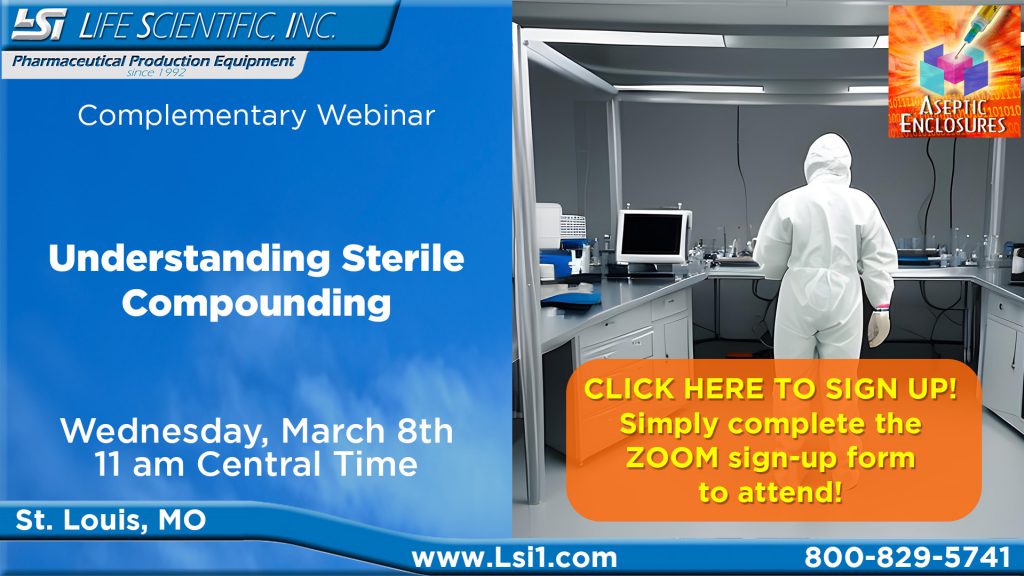
Prominently featured in the pharmaceutical manufacturing industry, a barrier isolator creates an aseptic environment for compounding parenteral (injectable), ophthalmic, and inhaled medications. Due to the significant risk posed by microbiological contamination, the critical area where the compounding takes place requires protection beyond that of a typical laboratory glovebox.
Since the first publication of USP’s General Chapter <797> Pharmaceutical Compounding—Sterile Preparations, compounding aseptic isolators (CAI) have offered the most economical alternative to constructing a dedicated cleanroom for sterile compounding. However, pharmaceutical compounding standards have undergone a major overhaul in recent years, including a developing revision of USP 797.
What is the new definition of an aseptic isolator?
According to the draft revision of USP 797 (released in September of this year), compounding aseptic isolators will be divided into two classifications: Restricted Access Barrier Systems (RABS) and Isolators. Compounding Aseptic Isolator Front Access For Sterilization
An isolator is defined as an ISO 5 enclosure that meets the following criteria:
- Uses rapid transfer ports or another type of decontaminated, high-integrity interface to transfer compounding materials into the isolator
- Uses an automatic sporicidal decontamination system
- Constantly maintains a significant overpressure relative to the surrounding environment
- Manufacturer provides documentation verifying that the isolator can maintain ISO 5 at all times
Any CAI that does not meet all of the isolator criteria would be classified as a restricted access barrier system (RABS). A RABS is an ISO 5 enclosure that provides a physical separation from the compounding area through the use of glove ports, but the openings for transferring materials would not provide the same level of protection as an isolator. In addition, the RABS is cleaned and decontaminated manually.
Can an isolator still be used without a cleanroom?
The answer is complicated but explained in this article we posted some time ago. https://asepticenclosures.com/can-an-isolator-still-be-used-without-a-cleanroom/
Under the current USP 797 guidelines, a compounding aseptic isolator may be used as a substitute for a cleanroom if it is certified to meet ISO 5 under dynamic conditions. Usually, the certifier will conduct particle tests and airflow studies while a technician is compounding and transferring materials.
Transferring Materials Into Compounding Aseptic Isolator Ante chamber. However, the revised version of USP 797 under development will require an isolator to be placed in minimum ISO 8 conditions (read: cleanroom) in order to have Beyond-Use Dates (BUDs) greater than 12 hours at room temperature (24 hours refrigerated). Essentially, any drug compounded outside of a cleanroom will have a limited BUD, regardless of how well isolated the compounding area is. A RABS can only be used in an ISO 7 environment, because it is not considered a true isolator.
These stricter isolator standards were actually developed back in August 2006 by the International Society for Pharmaceutical Engineering (ISPE), originally for implementation among pharmaceutical manufacturers. European pharmaceutical manufacturers and compounders have largely embraced these standards, but U.S. regulators have, up until now, refrained from imposing stricter requirements on the nascent compounding industry.
Following a series of high-profile incidents associated with contaminated compounded drugs, the FDA and USP have embarked on a crusade to strengthen enforcement of compounding standards, which includes a commitment to harmonize with international compounding standards. Although these new isolator standards are still under development, the FDA has already expanded its oversight to include outsourcing facilities, which are being held to pharmaceutical manufacturer standards (cGMP) until the FDA develops a specific set of standards for the compounding industry. Some of the more aggressive State Boards of Pharmacy are proactively discouraging the use of CAIs outside of a cleanroom, even if the current USP standards would normally allow it.
In any case, we feel like the Isolator is a far better Compounding area over the currently acceptable equipment under Cleanroom specifications, just because it presents a physical barrier between the pharmacist and the compounding process.
Get in touch with our USP compliance experts to learn more about the XLTC series of Aseptic Isolators for USP 797 Compliant processes. Call 800.418.9289
Check out our Linkedin page to stay updated about upcomming Events and oppertunities


Thank for the information, please visit ittelkom-sby.ac.id